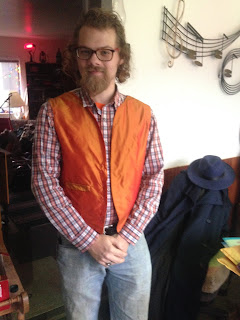An eyelet for an eyelet Supplies: 40" of thread doubled over (3 cents) a needle (20 cents) awl ($6) size 8 knitting needle ($3) scissors Before the days of the zipper, sewer and seamstresses had to get creative to get their clothes to stay on the body. During the 1860's, there were three main types outergarment closure: the button, hook and eye, and lacing. Lacing was the best for pulling an item tight and served not only to keep the garment on but was the most effective method for pulling garments tighter around the figure of the wearer. Eyelets and lacing can be seen most commonly on swiss waists, corsets, and ball gowns. It is most famously associated with corsets, lending to the style now even being referred to as "corset" closure even on outer garments and dresses. Done correctly, it is both pretty and functional. An eyelet is basically embroidery around a hole in your fabric to provide strength and keep the hole from fraying
Posts
Showing posts from December, 2018
- Get link
- Other Apps

★★☆☆☆Burda 2787 A Matter of Vests I used this pattern for its pants and vest. It does include two styles of coats but for what I wanted the pants and vests worked perfect. Pros The pattern pieces did make up nicely for the most part once I threw the instructions away. If you are feeling adventurous and just want to do your own thing then this pattern is for you! The sizing was actually a little big so it was very easy to fit on the the model and make adjustments. Cons This was bad. I have tried both the pants and vest for this and it was a nightmare. The instructions are terrible, could not follow what and where the instructions wanted done. Each piece is numbered but the instruction use the abbreviation of the name and it just makes it even more confusing. I was able to make a working vest with this pattern, but the pants just needed to be scrapped. They did not at all come out the right size or shape. I also took the collar off the vest just because
- Get link
- Other Apps
★★★★★ M7493 The Arsenic Dress If I did not enjoy Victorian reenacting so much, this pattern and dress would be enough to convert me to regency. The idea behind this dress was spawned by the suggestion of a friend to attend a regency ball in our area. Intrigued, the quest for the perfect first early 1800's dress pattern was spawned. After all, I am an avid Austen fan and drool over Kierra Knightly dressed in her beautiful flowing outfits. The fabric I chose due to its resemblance to the Scheele Green or "arsenic green" that woman between 1755 and the late 1800's were dying to get their hands on... literally. It was made literally from the green color of powdered Arsenic, and its deadly beauty lured in many an unsuspecting maiden. With the perfect fabric, only the perfect pattern would do and I chose the McCall's M7493 due to the jacket and the simplicity of the dress. Construction was fairly easy. The bodice, not including the sleev
- Get link
- Other Apps
Peterson's 1861 Pearl Diadem Time: 4 hours Cost $13.50 $10 pearls $2 boning $1.50 Velvet ribbon This headdress has been a bit of an obsession of mine. It has such a simple elegance to it, with the combination of the pearl and black velvet. The Daee ballgown will hopefully have velvet ribbon trim on it before the next ball, but knowing me, I'll probably be sewing it on in the car on the way to the ball. To go with that theme, this little headdress was just begging to be made. This was actually a pretty easy project, taking around four hours to make. It is found in Peterson's 1861 and seemed to follow the theme for the season of velvet diadems, with dangling decorations. The writer stated that the back could be left black to add flowers or more ribbon, but for the sake of authenticity, I left it like the picture with the frame, velvet, and dangling pearl beads, with pearls outlining the top of the frame The first step was to figure out what to
- Get link
- Other Apps
This is an old project I did for the Jackson Civil War Muster in my hometown. The idea was to do a patriotic red white and blue dress as my persona as a tradesman Northerner's daughter visiting the camps to help provide some moral and encouragement to the boys in blue. A person visiting the camps during the war would be their to support a relative or deliver some homemade items. Original apron at the Gettysburg museum. I liked how the stripes were set up so used this as the inspiration for the "skirt" of the flag apron. This one was an adult apron dated to the 1860's. From what I could dig up, this is a children's apron dated to early to mid 1860's that closes with a button closure and has a type of cotton ribbon formed into flowers. This was where the idea for the top of the apron came from. This is meant to represent the circular flags that were used during the era. The five stars are not folded as the example above, but rathe